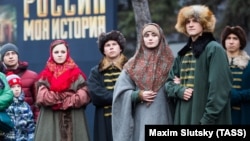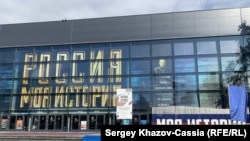MOSCOW -- If you enter the hall devoted to the 13th-century Russian Grand Prince Aleksandr Nevsky in one of Russia's new "history parks," you will find in huge letters the quotation "Boost your defenses in the west and look for your friends in the east."
"You might not read anything else about Aleksandr Nevsky," says graduate student Yekaterina Klimenko, who is working on a doctoral dissertation about the Russia -- My History exhibitions at the Polish Academy of Sciences. "But you will see that slogan."
Over the last half decade, 20 of the Russia -- My History exhibitions have opened in cities across Russia from Makhachkala in the North Caucasus republic of Daghestan to Yuzhno-Sakhalinsk on the Far Eastern island of Sakhalin. The flashy, hi-tech exhibitions feature interactive displays with touch-screen computers, animations, and 3D reconstructions -- all with the self-proclaimed aim of "bringing history out of black-and-white textbooks and into impressive, attractive, and simultaneously objective storytelling so that every visitor felt like a participant in the events of the more than 1,000-year history of his or her Fatherland," according to the project's website.
Indeed, the exhibitions' game-show atmosphere and flashing displays are about as far away from dry textbooks and dusty archives as it is possible to get.
Aleksandr Myasnikov, a former Soviet journalist who oversees the content of the exhibitions, told RFE/RL that the mission of the Russia -- My History project is "unity."
"We don't have the main thing," he said. "In America, they have the Fourth of July, a holiday everyone understands. We could have an excellent holiday -- marking the end of the Civil War. But can you tell me what date that was? You can't, and neither can I. There is no such holiday. A national idea for our country is also impossible.... You see, besides the Russia -- My History project, there is nothing else."
Criticism
Historians, however, have lambasted the project. In 2017, after the Education Ministry recommended the Russia -- My History project as a pedagogical resource, the independent Free Historical Society published an open letter criticizing the "panegyric tone" of the treatment of "every tsar without exception" and asserting that many exhibits "raise concrete questions relating to things the exhibition presents as facts."
"The Free Historical Society urges the Education Ministry to organize a professional evaluation of the Russia -- My History exhibitions and the official publication of its results and -- in the meantime -- to stop recommending these exhibitions as educational material," the letter concluded after a lengthy enumeration of specific controversial moments.
The main message that the exhibitions seem to be trying to instill is that Russia is strong when it is united around a powerful leader, and when it is not, it is vulnerable to nefarious machinations from abroad.
"It is the idea that Russian history is cyclical, and that the most important thing is the internal unity of the people," Klimenko told RFE/RL. "When that is present, Russia is a strong state. When it is absent, Russia becomes weak and endures the attacks of enemies, mostly from the West, but also from the East."
"When a nadir is reached, the people come together," she added. "First, because they see the suicidal nature of internal division and, second, because there is a leader who is capable of uniting them."
According to the exhibition, Russia passed through several periods of such weakness before being unified by leaders such as Aleksandr Nevsky, Dmitry Donskoi, Tsar Ivan the Terrible, and the tsars of the Romanov dynasty -- whose 300-year rule over Russia is portrayed as a time of "nearly flawless development." The February Revolution of 1917 is presented as a "betrayal" of the country by generals, students, and -- most insidiously -- "liberals" in the newly created State Duma, all of whom were egged on by the English ambassador and Freemasons.
"And then the people -- under the leadership of [Soviet dictator Josef] Stalin -- came to their senses and understood that they needed to return from idiotic slogans about the triumph of internationalism to basic traditions and again resume state-building," Klimenko explains, summarizing the Russia -- My History interpretation.
She notes that information about problematic aspects of this thesis, such as the reign of terror under Ivan the Terrible known by the Russian term oprichnina, and the political repressions under Stalin, is available at the Russia -- My History exhibitions. But it is hard to find, buried under huge and flashy slogans.
"The exhibition contains a lot of information -- there are thousands of pages of text that are very cleverly arranged," Klimenko explains. "If you want to find something about the repressions or the oprichnina or collectivization, you will find it. Or if you go to them with objections, they will tell you, 'It is all here.' But if you go there as an ordinary visitor, such information is not going to throw itself at you. The walls are covered with panels that have pictures and slogans."
Focus On Putin
The largest section of the exhibition is devoted to the current Russian president, Vladimir Putin. In addition, quotations from Putin decorate the other halls, citing him as an expert on various periods of Russian history.
"On the eve of World War I," one Putin quotation reads, "Russia did everything possible to convince Europe to resolve the conflict between Serbia and Austria-Hungary peacefully and without bloodshed. But Russia was not heeded and it was forced to respond to the challenges and to defend a fraternal Slavic people while defending itself and its citizens from foreign threats."
The history of the Russia -- My History project itself shaped what it ultimately became. Its roots go back to 1995, when the Russian Orthodox Church organized a series of exhibitions titled Orthodox Rus. Those exhibitions attracted little attention until they were taken under the wing of Archimandrite Tikhon Shevkunov. Shevkunov was described at the time as one of the most influential ideological figures in the Russian Orthodox Church and has been called "Putin's spiritual mentor" in the Russian press.
In 2011, the previously modest exhibitions were revamped with a major show in Moscow's Manezh exhibition hall, featuring the multimedia glitz that has become the defining feature of Russia -- My History. Then-President Dmitry Medvedev attended the show and, soon after, it was decided to create a similar show for the 400th anniversary of the Romanov dynasty in 2013.
Journalist Myasnikov was recruited to the team for that exhibition, which was ultimately seen by more than 300,000 people over its 20-day run in Manezh. It was subsequently sent on tour around the country with notable success.
That was followed in quick succession by shows devoted to the Rurik dynasty (1157-1598) and the periods from 1914-45 and from 1945-2016.
The first permanent Russia -- My History exhibition opened in pavilion No. 57 of the VDNKh exhibition center in Moscow in December 2015. Since then, 19 others have opened their doors across the country. According to the organizers, more than 5.5 million people have visited the centers since 2013. The exhibitions are often crowded with schoolchildren, students, cadets from military academies, and others who are brought there on field trips. Myasnikov told RFE/RL the centers are becoming an important element in the country's educational system.
Official Educational Material
In 2017, the Education Ministry officially recommended the Russia -- My History parks as educational material for students and schoolteachers.
This massive expansion was beyond the means of the Russian Orthodox Church, so in the run-up to the Romanov exhibition, the ostensibly nongovernmental Humanitarian Projects Foundation was created. The foundation gets most of its funding from the state-controlled Gazprom energy giant, as well as from government grants. Its managing director is former Gazprom lawyer Ivan Yesin, while Archimandrite Tikhon heads its "expert council."
It lists as "partners" Putin's presidential administration, the Moscow Patriarchate, the Culture Ministry, the Russian Military-Historical Society headed by Culture Minister Vladimir Medinsky, and a number of regional administrations.
Representatives of the foundation did not make themselves available to RFE/RL for comment on this story.
In 2017, Bloomberg reported that Gazprom had increased its "charitable" giving to a record 26.3 billion rubles ($438 million), most of which reportedly was earmarked for Russia -- My History. The foundation denied that report, claiming that it spent no more than 120 million rubles ($1.8 million) on each center, while the remaining costs were picked up by regional administrations or "other sponsors." RFE/RL's analysis of open-source information indicates that at least 10 billion rubles ($154 million) have been spent on the project.
The main people responsible for the content of the exhibitions now are former Soviet journalist Myasnikov and Pavel Kuzenkov, who studied history at the Russian Orthodox University and worked closely with Archimandrite Tikhon at the Sretensky Seminary. Kuzenkov is no longer with the project and refused an interview with RFE/RL about the project, which he described as "a clear example of the use of historical science in the service of political propaganda."
According to Myasnikov, Tikhon only worked on parts of Russia -- My History dealing directly with the Orthodox Church. Other sources, however, told RFE/RL that all the exhibition materials were checked by the archimandrite.
In 2015, the Humanitarian Projects Foundation decided to submit the Russia -- My History materials to professional historians for evaluation, says Vladislav Aksyonov, a senior researcher at the Institute of Russian History of the Russian Academy of Sciences.
"There were some rather basic fundamental criticisms of almost every display, every period," Aksyonov recalls. "After that, they decided to create a joint commission on methodology."
The director of the Institute of Russian History, Yury Petrov, served on the commission, as well as Yesin and Archimandrite Tikhon.
Aksyonov said virtually everything was rewritten.
"Not a single text satisfied our requirements because they were written by dilettantes," he said. "There was serious ideological bias -- for instance, pre-revolutionary Russia was presented as a sort of lost paradise."
After this process, the foundation added the Russian Academy of Sciences to its list of co-authors of the Russia -- My History texts; however, only a tiny fraction of the suggested changes were actually adopted, Aksyonov said.
When RFE/RL showed Aksyonov the Russia -- My History panels relating to his area of expertise, the 1917 revolution and the Civil War, he identified only one passage that had been changed as he had recommended.
Klimeniko said most of the original Russia -- My History materials remained unchanged after the evaluation, but new material was added to them.
"Detailed information about the repressions, beginning with the Civil War appeared," she said. "The exhibits became less emotional, but the ideological tendency remained."
Russia -- My History editor Myasnikov defended the exhibitions' approach, rejecting accusations of monarchism or justifying Stalinism.
"That impression is just a side effect of the structure [of the exhibition], which was intended to present facts and only facts, from which the visitors can draw their own conclusions," he told RFE/RL. "The exhibition is not propagandistic. It is just nonstandard."



